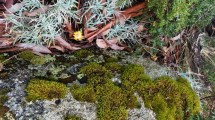Summary
-
1.
Combined spatial and color vision is studied by training honey bees to vertically oriented circular patterns consisting of two half circles of different brightness or hue. Spatial discrimination is quantified by determining the discrimination between the trained pattern and a test pattern with a different inclination of the contrast line between the two half circles.
-
2.
Bees discriminate patterns of pure hue contrast. The spatial discrimination of a pattern of optimal hue contrast is better than the discrimination of the equivalent black and white pattern.
-
3.
After training to a contrast line of α= −45 ° (Fig. 1), discrimination depends not only on the change of inclination of the contrast line (Δα, Fig. 1), but also on the direction of change (−Δα: clockwise rotated test pattern, +Δα: anticlockwise rotated test pattern). This is called the asymmetry effect. The asymmetry effect is a sensitive measure of the color specific action on spatial discrimination.
-
4.
In monochromatic UV bright/dark patterns discrimination is better, when the tested pattern displays an increased area of bright UV in the upper visual field. The effect is reversed in monochromatic orange bright/dark patterns; discrimination is better when the tested pattern displays a decreased bright area in the upper visual field (Figs. 3, 4).
-
5.
Achromatic (including UV) bright/dark patterns induce no asymmetry effect. Bright/dark patterns without UV show the asymmetry of the orange pattern. This confirms Wehner's (1972) findings.
-
6.
The color-specific effects are enhanced in heterochromatic patterns with optimal hue contrast (UV/bluegreen, blue/orange; Fig. 5a, b).
-
7.
The color specific effects depend on the inclination of the contrast line of the trained pattern. Asymmetry is reversed for both color pairs when α=90 ° (a vertical contrast line) is trained instead of α=45 °. There is no asymmetry effect if a horizontal contrast line (α=0 °) is trained.
-
8.
We interpret our results on three different levels. First, we use Wehner's (1972) model which assumes higher weight of the lower part of the visual field in pattern vision. We conclude, however, that this applies only for long wavelength colors. In UV light the upper part of the visual field should have higher weight. Second, we assume that bees prefer spontaneously patterns with a higher proportion of UV in the upper visual field. This explains the higher choice performance if the trained pattern has a higher proportion of UV in the upper part of the visual field, and the lower choice performance if the alternative pattern has a larger UV area in the upper visual field. Third, we compare our results with recordings from visual interneurons and show that our psychophysical data are useful for interpreting interneuron recordings.
Similar content being viewed by others
References
Daumer K (1956) Reizmetrische Untersuchungen des Farbensehens der Bienen. Z Vergl Physiol 38:413–478
Erber J, Menzel R (1977) Visual interneurons in the median protocerebrum in the bee. J Comp Physiol 121:65–77
Heiversen O von (1972) Zur spektralen Unterschiedsempfindlichkeit der Honigbiene. J Comp Physiol 80:439–472
Henderson ST (1970) Daylight and its spectrum. Hilger, London
Hertel H (1980) Chromatic properties of identified interneurons in the optic lobes of the bee. J Comp Physiol 137:215–231
Kien J, Menzel R (1977a) Chromatic properties of interneurons in the optic lobe of the bee. I. J Comp Physiol 113:17–34
Kien J, Menzel R (1977b) Chromatic properties of interneurons in the optic lobe of the bee. II. J Comp Physiol 113:35–53
Maxwell JC (1855/57) Experiments on colour, as perceived by the eye, with remarks on colour-blindness. Trans R Soc (Edinburgh) 21:275–297
Menzel R (1967) Untersuchungen zum Erlernen von Spektralfarben durch die Honigbiene,Apis mellifica. Z Vergl Physiol 56:22–62
Menzel R (1979) Spectral sensitivity and colour vision in invertebrates. In: Autrum H (ed) Handbook of sensory physiology, vol VII/6A. Springer, Berlin Heidelberg New York, pp 503–580
Menzel R, Blakers M (1976) Colour receptors in the bee eye — morphology and spectral sensitivity. J Comp Physiol 108:11–33
Milde J (1977) Verteilung der spektralen Empfindlichkeit über das Auge der Bienenarbeiterin und spektrale Schwellenfunktion in unterschiedlicher natürlicher Umgebungshelligkeit. Diplomarbeit, FB Biologie, Freie Universität Berlin
Munsell AH (1905) A color notation. Ellis, Boston
Munsell AH (1929) Book of colors. A revision and extension of the atlas of the Munsell color system. Munsell Color Company Inc., Baltimore
Ostwald W (1923/24) Farbnormen-Atlas. Unesma, Leipzig
Padgham CA, Saunders JE (1975) The perception of light and color. Academic Press, New York London
Richter M (1981) Einführung in die Farbmetrik, 2. Aufl. de Gruyter, Berlin
Riehle A (1981) Color opponent neurons of the honeybee in a hetero-chromatic flicker test. J Comp Physiol 142:81–88
Rodieck RW (1973) The vertebrate retina. Freeman, San Francisco
Rose R, Menzel R (1981) Luminance dependence of pigment color discrimination in bees. J Comp Physiol 141:379–388
Runge PO (1840) Farbenlehre 1806–1810. In: Hinterlassene Schriften von PO Runge. Perthes, Hamburg
Rushton WAH (1972) Pigments and signals in color vision. J Physiol (Lond) 224:1–31
Snyder AW, Menzel R, Laughlin SB (1973) Structure and function of the fused rhabdom. J Comp Physiol 87:99–135
Wehner R (1972) Dorso-ventral asymmetry in the visual field of the bee,Apis mellifica. J Comp Physiol 77:256–277
Wehner R, Flatt I (1977) Visual fixation in freely flying bees. Z Naturforsch 32c:469–471
Wehner R (1981) Spatial vision in arthropods. In: Autrum H (ed) Handbook of sensory physiology, vol VII/6C. Springer, Berlin Heidelberg New York, pp 287–616
Author information
Authors and Affiliations
Rights and permissions
About this article
Cite this article
Menzel, R., Lieke, E. Antagonistic color effects in spatial vision of honeybees. J. Comp. Physiol. 151, 441–448 (1983). https://doi.org/10.1007/BF00605460
Accepted:
Issue Date:
DOI: https://doi.org/10.1007/BF00605460




